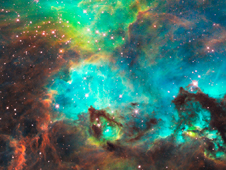To mark the event, a photo was taken this week of a star formation region in the Large Magellanic Cloud. In October, the last upgrade mission to Hubble will be launched

The speed meter of the Hubble Space Telescope marked this week the hundred thousandth revolution in the 18 years of the telescope's operation, years of discoveries. To mark the event, it was decided to direct the mourner to photograph an area of regeneration and the creation of new stars. Hubble focused on a small section of the Tarantella Nebula near the star cluster NGC 2074. The region is buzzing with new star formation, apparently due to a supernova explosion. It is 170 light-years away from us, and is considered one of the most active regions of new star formation in the local group of galaxies.
The image reveals ridges and valleys of dust, a formation known as the "pillars of creation" and thin filaments of gas glowing wildly under overwhelming ultraviolet radiation. The area is at the edge of a dark molecular cloud. The strong radiation erupts from a cluster of young stars and arrows and shapes the wall of the nebula through its slow erosion. It is possible that another young cluster is hiding within the circle of light blue gas.
This configuration stretches over 100 light years and looks like a land from legends. Dark towers of dust grow within the wall of hot gas on the surface of the molecular cloud. The seahorse-like formation in the lower right is about 20 light-years long, about 4 times the distance between the Sun and the nearest star Alpha Centauri.
The region is contained within the Large Magellanic Cloud, a satellite galaxy of the Milky Way. This is a spectacular natural laboratory for observing star formation regions and their development. Dwarf galaxies such as the Large Magellanic Cloud are considered the primitive building blocks of large galaxies.
"This morning marked the most important telescope since Galileo's telescope, another important milestone - one hundred thousand laps around the Earth," noted Senator Barbara Mikulski, chairman of the Senate Commerce, Law and Science Subcommittee - the committee dealing with NASA funding. "Hubble has provided us with insights into the origin of the universe, and I am proud of all those at the Goddard Space Center and the Space Telescope Science Institute for contributing to these important discoveries. The whole world is looking forward to Hubble's servicing mission scheduled for October 2008, where Hubble will receive new scientific instruments, as well as new batteries and gyroscopes. The service mission will extend Hubble's life and give us a more powerful view of the universe. The Hubble telescope can do this and the best years are still ahead of it.” Mikulski concluded.

8 תגובות
http://en.wikipedia.org/wiki/Orbital_period
My father, I'm sorry for the trouble, how do I search the science website for my questions about the station
to the point
Why did you refer to the words "do you consider a certain point"?
Why consider her?
If you find it appropriate, explain your question and then maybe we can answer.
Good Day
Sabdarmish Yehuda
It is allowed to thread, that the photography is spectacular..beyond all the details.??.amazing.
"Above a certain point" that's exactly what I asked about. Do you consider that particular point or not...
It would be very interesting to compare one of the first photographs of this region in the Large Magellanic Cloud with the current photograph, it will give an important idea if the movement calculated according to the Doppler effect is really visible in the field. The great precision of the telescope and the great amount of time that has passed should (maybe) allow this.
Another comparison should be made with my photographs of the Cancer Nebula (a supernova that was seen about 950 years ago). And also with my photos of a super nova seen in the Large Magellanic Cloud in the eighties - SN1987A.
Good Day
Sabdarmish Yehuda
Good morning, our points
To your question, the Hubble makes a revolution every hour and a half or so without anything to do with the rotation of the Earth, that is, in a day it makes about 16 revolutions that pass each time in a different orbit over the Earth. There are websites where you can see when it will pass over a certain point on Earth.
Good Day
Sabdarmish Yehuda
The number of revolutions relative to the surface of the rotating Earth?